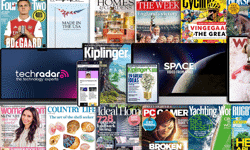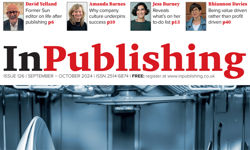Take a town. Take a sample of magazine buyers in that town. Then start to play around with their magazine consumption patterns. Stand back and monitor what happens and why. Then add in some unusual consumer promotions and in-store retail displays. Stand back again and track where the sales take place and why.
The idea of building a "sales laboratory" in a defined geographical area is what lies behind Magazine Town, creating a mix of research and promotion. The first magazine town was put together for PPA by Wessenden Marketing in Guildford, Surrey and was part of the PPA’s pioneering Magazine Week initiative undertaken at the end of September 2007, which was designed to boost sales and increase awareness of the diversity of the magazine industry.
There were three key activities in Guildford (see box 1 below), but the main one was a test which centred on flexing the consumer’s magazine repertoire (see box 2 below for methodology). When existing magazine readers are stimulated to buy more magazines, what happens? Do they simply buy more of the same types of magazine that they would normally read? Or do they become more adventurous and sample new titles? Do they go for the known, big brands? Or do they dip into specialist markets? And how much extra time do they spend reading magazines as a result?
The answers to these questions are intriguing and will be revealed in full at industry forums which PPA is currently organising. In summary, the results show that most magazine consumers are simply not aware of the full range of magazines available, but that they can be prompted to move outside their current "safe" repertoire of titles into new territory if there is a sufficiently compelling promotional mechanic to make them do so. The clear implication is that there are more magazine sales to be had on the back of a broad-based consumer awareness campaign – the whole raison d’être of Magazine Week.
This was the main focus of Magazine Town - how to flex the consumer’s repertoire of magazines. Yet in addition, a number of retail issues were also investigated, as it became clear from the project that the consumer’s whole perception of the size and shape of magazines as a medium is largely formed by what they see on retailers’ shelves: retail is, quite literally, the "shop window" for the industry. So, what do magazine consumers think about the shops they buy their magazines from?
Where do they normally buy their magazines?
Before the Magazine Town test began, the panellists were asked where they normally bought their magazines.
| Channel | % |
| WHSmith | 70% |
| Via subscription | 67% |
| Supermarket | 52% |
| Local newsagent | 18% |
| Petrol station | 8% |
| Convenience store | 7% |
| Other | 5% |
The fact that the panel was recruited from publishers’ own contact lists (a mix of subscribers, competition entrants, prospects, etc.) is reflected in the importance of subscriptions as a channel. Yet all the subscribers also bought magazines regularly from retail shops and all the panellists bought their magazines from more than one shop. The consumer is "channel neutral" – they buy different magazines in different ways at different times, dependent on what is most appealing and convenient at that moment. Another conclusion from the panel was that magazine purchasing does not normally drive the main shopping mission, but is an added extra, often to the food shopping trip. This factor lies behind the continued growth of supermarkets as a magazine channel. It also underlines the fact that the magazine purchase is not always "front of mind" and tends to be polarised at the two extremes: it is either an unthinking, habitual purchase on "autopilot" or a very impulsive action based on an assessment of covers and coverlines at the magazine racks themselves.
Where did they buy their magazines during the test?
When the panellists were prompted to think outside their normal repertoire, they instinctively went to the WHSmith outlets in the area which accounted for almost 80% of the voucher purchases during the month, due to the sheer range available and the space to browse. The share taken by WHSmith grew during the month and it was the supermarkets who took a direct hit as a result. What was disappointing was the fact that the independent outlets in the area picked up only 4% of the voucher purchases. The panellists’ views of their local newsagents varied dramatically. On one hand, some felt that these shops’ ranges were too small and that the proprietors were unhelpful, actively discouraging browsing and probably unlikely to want to get involved in the voucher scheme. On the other hand, others felt that their local newsagent was the best place to go as they would have suggestions as to which magazines to try and would make the effort to obtain any magazine that they did not carry on the shelf. The independents appear to represent the best and the worst of magazine retailing in the eyes of the consumer.
Why do they buy their magazines at particular shops?
So, what factors affect where consumers go to buy their magazines? The panellists were asked to score a range of issues, Retailer Key Performance Indicators (KPIs), on a scale of 1 to 5 as to how important these were in shaping their choice of shop. "Convenient location" and "range" come out clearly top, but a "logical display" to make finding the magazines easy was also very important.
Which specific shops do they like?
Panellists were asked to score specific types of retailers according to these same Retailer KPIs. WHSmith came out a clear top, getting the highest score in every area apart from "convenient location" which was won by local newsagents. In the overall scores, the indies just squeezed ahead of the supermarkets as a better place to shop for magazines.
What suggestions do they have for magazine retailers?
The panellists were asked to suggest how retailers could generally make buying magazines easier and more enjoyable. The two key improvements were:
1. To encourage browsing by providing more space and giving the "permission" to flick through the range. Seating and coffee bars were also suggested, with Borders being a model mentioned even though the chain does not have an outlet in Guildford.
2. To make the magazine displays more logical and neat with clear sections and divisions supported by clear signage and tidy, well-replenished shelves.
Yet, behind these broad suggestions lay a range of more specific ideas:
* Placing magazine racking next to the tills.
* The ability to order subscriptions in-store.
* An online directory of every magazine available.
* In-store LCD screens to highlight new issues and special promotions.
* Taking magazines out of their polybags to allow browsing – polybags generated very strong feelings among the panellists, mainly negative!
* Managers’ selections of their favourite titles, as in bookshops.
* Setting up a magazine reading club, similar to a book reading club.
* Having more in-store events like Magazine Night and "meet the editor" events.
The whole Magazine Town project emphasised that the reasons why people buy specific magazines are as varied as the magazine range available, but that the broad appeal of magazines is simple and universal to an extent that publishers themselves perhaps sometimes underestimate. Yet the pressures of the shopping trip can dominate and the repertoire can become set and repetitive and the actual navigation of the magazine racks almost pre-programmed. What Magazine Town illustrated was the electrifying effect of leading regular magazine readers to look beyond their normal repertoire into a world of magazine choice which most suspected was there, but which was larger and richer than they had appreciated. Retailers have a pivotal role in shaping this awareness.
Standing back from the detail of the test, there is a nagging suspicion: that for an industry which creates some of the most sophisticated and attractive consumer products, relatively little thought and creativity goes into how those products are displayed at the end of the supply chain at the point of sale. Magazine racks which are "clean", "neat" and "tidy" is a good start, but cannot be the acme of consumer marketing or the way to spark the shopper into truly sampling the full range of magazines that are out there on the market.
There is a clear opportunity for the industry to move our whole consumer marketing forward. That opportunity is what Magazine Week 2008 will be all about.
| Box 1: The Magazine Town 2007 Activity The Repertoire Test The behaviour and attitudes of a sample of magazine readers were monitored when they were prompted to read magazines outside their normal repertoires. Magazine School A local school was taken over for a range of activities: * The pupils’ media consumption and attitudes were researched. * Talks about careers in magazine publishing were given. * Prominent editors gave a Magazine Masterclass on the process of how a specific issue was put together. * A writing competition was launched in the school with the winners having their work published in a special magazine. * A local publishing company gave a Design Masterclass on how to create a better-looking school magazine. Magazine Night The main WHSmith outlet in the town centre was taken over for an open evening, when invited magazine readers could browse the shelves and meet the editors of some of their favourite magazines. |
| Box 2: The Repertoire Test Methodology A panel of 50 existing magazine readers was recruited in the Guildford / Godalming area, representing a cross section of the UK population. They were provided with vouchers for redemption against any magazine of their choice, effectively doubling their magazine consumption for four weeks free of charge. In return, they completed a weekly online diary during the month of September to track what they bought and where, with a final questionnaire seven weeks later to explore their settle-down purchasing habits. In addition, they were invited to an open evening at a large WHSmith outlet in Guildford town centre in the middle of the test to talk through how the whole project was progressing. |










